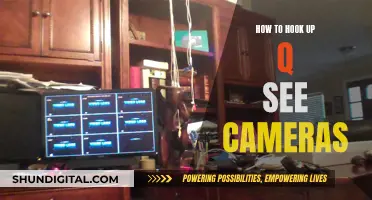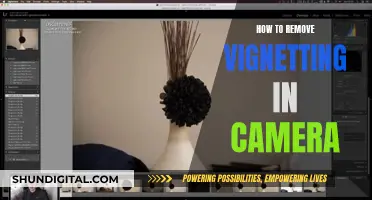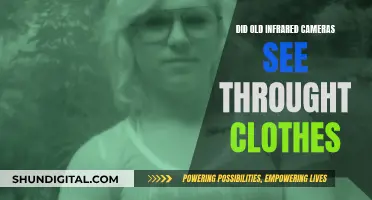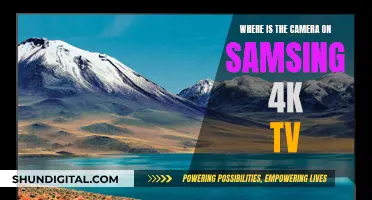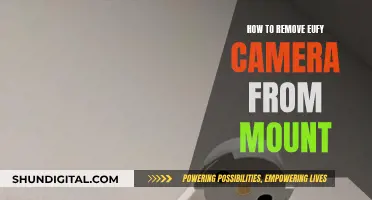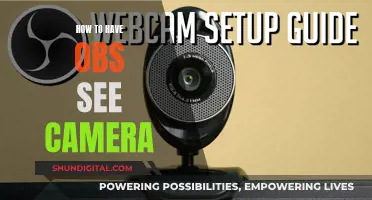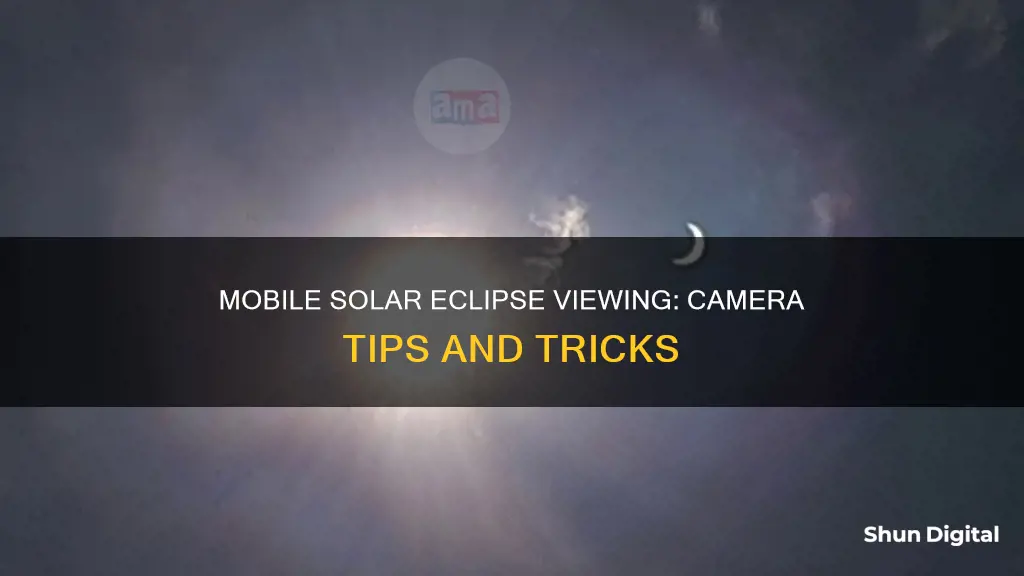
Capturing a solar eclipse using a mobile phone camera is possible, but it requires careful preparation and the right equipment to protect your device and your eyesight. The sun can be extremely damaging to your eyes, and you should never look directly at it without proper eye protection. The same goes for your phone – you will need a solar filter to avoid damaging your camera sensor. Experts recommend using a tripod to avoid shaky footage and to compose your shot with interesting scenery, such as trees or buildings, as the eclipse will change the light and shadows. You should also turn off your flash, as this will disturb the natural light.
| Characteristics | Values |
|---|---|
| Camera Flash | Turn off the flash before totality |
| Zooming | Avoid pinching the screen to zoom in on the solar eclipse |
| Image Resolution | Zooming in lowers image resolution |
| Angle | Go super wide-angle or portrait |
| Focus | Lock the focus on your smartphone |
| Burst Mode | Use burst mode to capture the diamond ring |
| Image Format | Shoot in RAW image format |
| Video Mode | Don't shoot a handheld video |
| Tripod | Shoot video using a tripod |
| Selfie Mode | Place a solar filter over the front camera lens |
What You'll Learn

Use a solar filter to protect your device and eyesight
It is imperative to protect your eyes and your device when observing a solar eclipse. A solar filter is an astronomical filter that protects your eyes and equipment from the sun's intense brightness. They block or reduce nearly all sunlight, allowing you to observe solar phenomena safely.
To photograph a solar eclipse with your mobile phone, you will need the right solar filter in front of your camera lens. The filter must be specifically designed for solar viewing, and it should be larger than the lens itself. Keep the filter on at all times if you are in a location where the eclipse is only partially visible.
You can purchase ISO-certified filters (ISO 12312-2) to protect your phone from damage. These filters are essential, as the sun's brightness can permanently damage your device's image sensor if pointed directly at it.
It is also crucial to protect your eyesight when observing a solar eclipse. Looking directly at the sun, even during an eclipse, can cause permanent damage to your retina, a condition known as "eclipse blindness." Solar filters block harmful ultraviolet (UV) and infrared (IR) radiation, allowing only a tiny amount of visible light to pass through. Ensure that your solar filter is properly placed and covers your entire lens.
Additionally, consider using a tripod to stabilize your phone and avoid blurry images. You can also use a delayed shutter release timer to capture sharp shots without jiggling the camera.
By following these instructions and using the appropriate solar filters, you can safely use your mobile phone to observe and photograph a solar eclipse, protecting both your device and your eyesight.
Adjusting Honda Lane Watch Camera: Tips and Tricks
You may want to see also

Don't use eclipse glasses or handheld viewers with your camera
How to Watch a Solar Eclipse with Your Mobile Camera
It is not advisable to use eclipse glasses or handheld viewers with your mobile camera when viewing a solar eclipse. This is because standard lenses on smartphones are very small and do not have the resolution or protective filters needed for safe and successful solar photography.
Pointing your camera at the sun may damage the phone's sensor. The sun is an extremely bright object, and when you point your camera at it, a lot of heat is generated, which can damage the sensor.
Experts advise that if you want to photograph the sun, you should use a proper solar filter or a camera with a special solar protector. These filters must be made specifically for solar viewing and placed in front of your cellphone camera to protect both your device and your eyesight.
If you are observing the sky in a location where the total eclipse is visible, you can take off the solar lens entirely and capture unfiltered images. However, this moment only lasts for a couple of minutes, so be prepared and have a plan.
For those who want to use their phone to view the eclipse indirectly, there are other options. You can create a simple pinhole projector using your phone and a piece of cardboard or paper. Poke a small hole in the cardboard and hold it between the sun and a flat surface, such as the ground or another piece of paper. The sunlight passing through the pinhole will project an image of the partially eclipsed sun onto the surface, which you can observe safely.
Remember, there is no safe time to look at the sun without protection, not even for a split second. So, whether you're using your phone or eclipse glasses, always make sure to protect your eyes and your device when viewing or photographing a solar eclipse.
Mastering Camera IQ: A Guide to Understanding Your Camera's Settings
You may want to see also

Photograph the effects of the altered lighting
Light is one of the most important elements of photography. It can be used to create emotions in a photo and to complement the subject. The position and quality of light can affect the final image, from clarity to tone to emotion.
During a solar eclipse, the lighting will be altered, and you can use your phone to capture the effects of this altered lighting. However, it is important to note that you should not point your phone directly at the sun during a solar eclipse, as it may damage your phone's sensor.
- Keep your head down and look under leafy trees for crescent-shaped projections of the eclipsed sun on the ground.
- Pay attention to how the strange light affects people and animals.
- Look for shadow bands, which are mysterious gray ripples that snake over the ground just before and after the total eclipse.
- Use your phone to capture the changing environment and the 360-degree sunset.
- Use a tripod to prevent shakiness and to stabilise the camera.
- Use a delayed shutter release timer to snap shots without jiggling the camera.
- Try using your phone's HDR (High Dynamic Range) and Night modes to enhance photographs during the darkened moments of the total eclipse.
- If you want to photograph the sun as it becomes partially covered, take an extra pair of ISO-certified solar eclipse glasses, cut them, and tape one of the filters over your phone's camera lens. Make sure all lenses are covered if your smartphone has several.
- During the few minutes of totality, when the sun is completely obstructed, you can take off the solar lens and capture unfiltered images.
School Bus Camera Footage: Who's Watching?
You may want to see also

Use a tripod to avoid shaky images
Capturing the perfect image of a solar eclipse can be tricky, especially when using a mobile phone camera. One of the biggest challenges is avoiding shaky or blurry images. Here are some tips to help you use a tripod to get clear, stable shots of this incredible phenomenon:
Invest in a Good Tripod:
First, you'll need to get your hands on a tripod. Not all tripods are created equal, so it's worth investing in a sturdy and stable model specifically designed for mobile phone use. This will ensure your phone stays securely in place during the eclipse.
Mount Your Phone:
Once you have your tripod, mount your mobile phone on it. Adjust the tripod's height and angle to get the desired framing for your shot. Make sure the phone is securely attached to the tripod to avoid any accidental drops or shifts during the photography session.
Find the Right Location:
Place the tripod in a location that offers a clear view of the sky and the eclipse path. Ensure there are no obstacles, such as trees or buildings, that might obstruct your view. If possible, scout the location beforehand to familiarize yourself with the surroundings and choose the best spot.
Use a Remote Shutter or Self-Timer:
To further reduce the risk of camera shake, consider using a remote shutter release or the self-timer function on your phone. This will allow you to trigger the shutter without physically touching the phone, minimizing vibrations and ensuring sharper images.
Practice and Prepare:
Before the eclipse, take some time to practice setting up your tripod and phone, and experiment with different camera settings. Familiarize yourself with the process so that when the eclipse occurs, you can work efficiently and confidently. Check your equipment, ensure your phone is charged, and clear up space on your device for the images you'll be capturing.
Stabilize Your Tripod:
Ensure that your tripod is stable and secure. If it's windy, consider weighting it down or anchoring it to the ground to prevent it from toppling over or shaking excessively. You can also use a monopod if you find a tripod too cumbersome, although it may not provide the same level of stability.
Protect Your Eyes and Phone:
Remember, it is unsafe to look directly at the sun, even during a solar eclipse, without proper eye protection. Always use eclipse glasses that meet international standards (ISO 12312-2) to protect your eyes. Additionally, use a certified solar filter (ISO 12312-2) in front of your phone's lens to prevent damage to the sensor.
By following these tips and using a tripod, you'll be well on your way to capturing stunning and stable images of the solar eclipse with your mobile phone camera. Remember to plan ahead, practice, and always prioritize eye and equipment safety during the event.
Are School Cameras Watched?
You may want to see also

Capture the human experience of watching the eclipse
Capturing the human experience of watching the eclipse is an important part of documenting the event. It's a chance to showcase the emotions and reactions of people as they witness this rare celestial phenomenon. Here are some tips to help you capture those moments:
Focus on the people around you: Instead of spending all your time looking at the eclipse through your phone, turn your camera lens towards the people around you. Capture their expressions, their awe-struck faces, and their emotions as they take in this extraordinary event. As NASA photographer Bill Ingalls notes, "The real pictures are going to be of the people around you pointing, gawking, and watching it. Those are going to be some great moments to capture to show the emotion of the whole thing."
Document the reactions: The eclipse is a captivating and often emotional experience for many. People may be laughing, crying, shouting, or simply staring in wonder. Capture these reactions to convey the impact of the eclipse on people's lives. Take photos or videos of people pointing at the sky, covering their mouths in surprise, or hugging each other in awe. These images will convey the collective sense of wonder and community that an eclipse can create.
Include the environment: While focusing on people's reactions, also try to include their surroundings in your photos or videos. Capture the eerie lighting, the shadows, and the natural pinhole projections caused by the eclipse. Include the landscape, the trees, and any unique effects the eclipse has on them. This will add context and atmosphere to your images, showcasing the impact of the eclipse on the natural world.
Use a variety of angles: Try different angles and perspectives to capture the human experience from multiple viewpoints. Take photos from a distance to show people gathered together, watching the eclipse. Get up close to capture the intimate details of someone's face as they react to the event. Experiment with wide-angle shots to include more of the environment and showcase the scale of the event.
Be prepared: The eclipse will only last for a brief period, so make sure you're prepared beforehand. Have your camera settings ready, and consider using a tripod to stabilize your shots. Practice different compositions and angles in advance so that you can quickly capture the moments that matter during the eclipse.
Remember, while capturing the human experience, it's important to also protect your eyes and your camera sensor. Use eclipse glasses or certified filters when viewing or photographing the eclipse, except during the brief period of totality when the moon completely blocks the sun. Enjoy this rare celestial event and make sure to capture the memories to cherish for years to come!
Accessing Tesla's Cameras: A Step-by-Step Guide
You may want to see also
Frequently asked questions
You can watch the solar eclipse on your mobile camera by using a solar filter. The filter must be made specifically for solar viewing and should be larger than the lens itself. You can tape the filter onto your phone or purchase one that screws in front of the lens.
It is important to note that you should never look directly at the sun during an eclipse without proper eye protection, as it can damage your eyes and even cause blindness.
Yes, you can still use your phone to watch a solar eclipse safely without a solar filter. You can create a pinhole projector using your phone, a piece of cardboard, and some foil. Poke a small hole in the cardboard and hold it between the sun and a flat surface to project an image of the eclipse, which you can then observe safely.
You can also watch livestreams of solar eclipses online through various organizations, observatories, and news outlets.
Yes, you can place a solar filter over the front camera lens of your phone to capture the sun during the eclipse. However, the sun will likely appear very small in the frame. You can also use a solar viewer or a sheet of solar filter to cover the sun and get a clearer picture.


